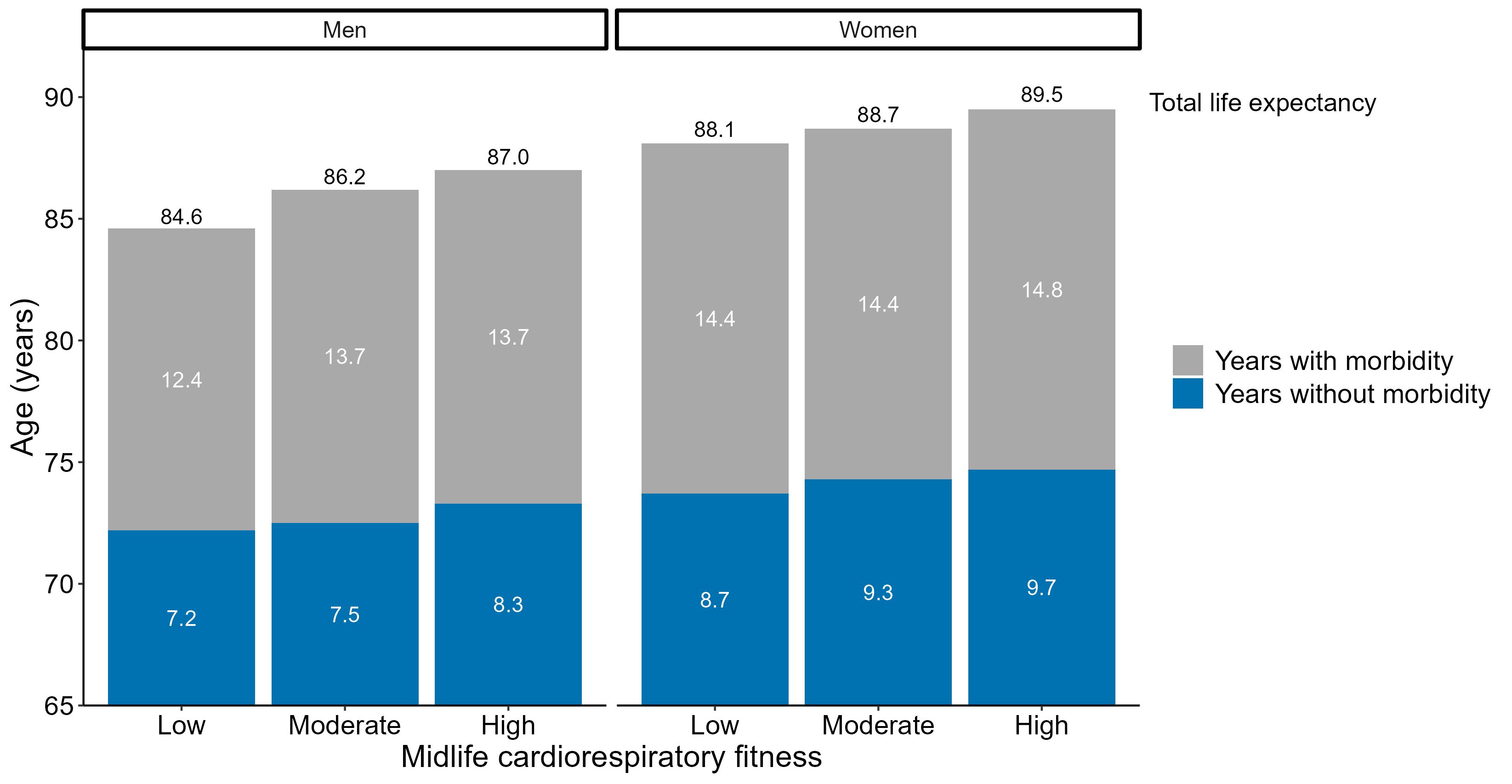Final ID: P1012
Higher Cardiorespiratory Fitness in Midlife is Associated with Postponement of Morbidity and Longer Life
Abstract Body: Introduction: Delaying the onset of disease so that morbidity is compressed into a shorter period before death can improve quality of life and lower healthcare costs. Cardiorespiratory fitness (CRF) is one of the strongest known predictors of health, but its association with morbidity compression is unclear.
Methods: We examined whether higher CRF in midlife is associated with morbidity compression and life extension (i.e., living a longer, healthier life) among older adults. The sample included 26,237 Cooper Center Longitudinal Study participants (n=19,569 men; n=6,668 women) who had CRF estimated via maximal treadmill test at a mean age of 48.5 (SD: 9.7) years and were later enrolled in Medicare. Participants were healthy through age 66.5 years. Morbidity was defined as incidence of any of the following 11 chronic conditions identified from the Chronic Condition Warehouse: heart failure, ischemic heart disease, stroke, diabetes, chronic obstructive pulmonary disease, chronic kidney disease, dementia, or colorectal, lung, breast, or prostate cancer. Illness-death models were used to estimate the likelihood of transitioning between states of health, morbidity, and death by relative CRF, categorized as low (quintile 1), moderate (quintiles 2-3), or high (quintiles 4-5) based on age- and sex-specific distributions. Sex-stratified models adjusted for year of birth, age, smoking, BMI, fasting glucose, cholesterol, and blood pressure. Model parameters were used to estimate Aalen-Johansen state probabilities, and simulated Markov chains were used to calculate expected occupancy times in each state up to age 100.
Results: Among men, high (vs. low) CRF was associated with postponement of morbidity (HR: 0.78, 95% CI: 0.72, 0.84) and death after morbidity (HR: 0.61, 95% CI: 0.54, 0.69). Among women, high (vs. low) CRF was similarly associated with postponement of morbidity (HR: 0.83, 95% CI: 0.73, 0.94) but not death after morbidity (HR: 0.85, 95% CI: 0.67, 1.09). On average, participants with high (vs. low) CRF developed morbidity 1.0 (women) – 1.1 (men) years later and had longer life expectancies (women: age 89.5 vs. 88.1; men: age 87.0 vs. 84.6) (Figure).
Conclusions: High CRF at midlife was associated with a roughly 1-year extension of healthy life and a 1.4-2.4-year extension of total life expectancy. Interventions that improve CRF through lifestyle behaviors may contribute to meeting AHA’s 2030 Impact Goal of increasing healthy life expectancy by two years.
Methods: We examined whether higher CRF in midlife is associated with morbidity compression and life extension (i.e., living a longer, healthier life) among older adults. The sample included 26,237 Cooper Center Longitudinal Study participants (n=19,569 men; n=6,668 women) who had CRF estimated via maximal treadmill test at a mean age of 48.5 (SD: 9.7) years and were later enrolled in Medicare. Participants were healthy through age 66.5 years. Morbidity was defined as incidence of any of the following 11 chronic conditions identified from the Chronic Condition Warehouse: heart failure, ischemic heart disease, stroke, diabetes, chronic obstructive pulmonary disease, chronic kidney disease, dementia, or colorectal, lung, breast, or prostate cancer. Illness-death models were used to estimate the likelihood of transitioning between states of health, morbidity, and death by relative CRF, categorized as low (quintile 1), moderate (quintiles 2-3), or high (quintiles 4-5) based on age- and sex-specific distributions. Sex-stratified models adjusted for year of birth, age, smoking, BMI, fasting glucose, cholesterol, and blood pressure. Model parameters were used to estimate Aalen-Johansen state probabilities, and simulated Markov chains were used to calculate expected occupancy times in each state up to age 100.
Results: Among men, high (vs. low) CRF was associated with postponement of morbidity (HR: 0.78, 95% CI: 0.72, 0.84) and death after morbidity (HR: 0.61, 95% CI: 0.54, 0.69). Among women, high (vs. low) CRF was similarly associated with postponement of morbidity (HR: 0.83, 95% CI: 0.73, 0.94) but not death after morbidity (HR: 0.85, 95% CI: 0.67, 1.09). On average, participants with high (vs. low) CRF developed morbidity 1.0 (women) – 1.1 (men) years later and had longer life expectancies (women: age 89.5 vs. 88.1; men: age 87.0 vs. 84.6) (Figure).
Conclusions: High CRF at midlife was associated with a roughly 1-year extension of healthy life and a 1.4-2.4-year extension of total life expectancy. Interventions that improve CRF through lifestyle behaviors may contribute to meeting AHA’s 2030 Impact Goal of increasing healthy life expectancy by two years.
More abstracts on this topic:
Changes in Dietary Intake, Physical Activity and Cardiometabolic Risk Factors in University Students
__PRESENT
Bernier-bergeron Frederique, Plouffe Jacques, Blackburn Patricia
Publicly-Insured Patients Have Lower Rates of Cardiac Rehabilitation Enrollment: A Statewide Experience in Michigan__PRESENT
Pedamallu Havisha, Mantey Julia, Sukul Devraj, Keteyian Steven, Pagani Francis, Hawkins Robert, Likosky Donald, Thompson Mike

